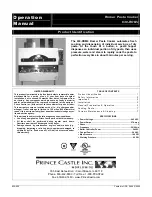
11
ADDITIONAL INGREDIENT NOTES
Important: Exact measurements for ingredients are the most important part of baking. It is the key to getting great texture and consistency
in your bread. Make sure to measure all ingredients exactly.
BAKING POWDER
Double-acting baking powder is a leavening agent used in quick breads and cakes. This type of leavening agent does
not require rising time before baking, as chemical reaction works when liquid ingredients
are added and again during baking process.
BAKING SODA
Baking soda is another leavening agent, not to be confused or substituted for baking powder.
It also does not require rising time before baking, as chemical reaction works during baking process.
EGGS
Eggs add richness and velvety texture to bread dough and cakes. When recipe calls for egg(s),
large egg(s) at room temperature should be used.
FATS
Butter, margarine and oil shorten or tenderize the texture of yeast breads. French bread gets unique crust and
texture from the lack of added fat. However, breads that call for fat stay fresh longer.
If butter is used directly from refrigerator, it should be cut into small pieces for easier blending
during kneading process.
LIQUIDS
All liquids should be warm 80ºF/27ºC to 90°F/32°C for all recipes. Liquids, such as milk, water or a combination of
powdered milk and water, can be used when making bread. Milk will improve flavor,
provide velvety texture and soften the crust, while water alone will produce a crispier crust. Vegetable
or fruit juices and potato water may be used for flavor variety.
SALT
Salt is necessary to balance flavor in breads and cakes; it also limits growth of yeast. Changing the amount of salt in
a given recipe may result in shorter, gummier bread. When first making a type of bread, do not increase or decrease
amount of salt shown in the recipe.
SUGAR
Sugar is important for color and flavor of breads. It also serves as food for yeast since it the supports fermentation
process. Recipes in this book that call for sugar require granulated sugar.
Important: Do not substitute powdered sugar. Artificial sweeteners cannot be used as substitute,
as yeast will not react properly with them.
CLIMATE CHANGES & BAKING
• In high-altitude areas (over 3,000 feet), dough tends to rise faster
as there is less air pressure. Therefore, less yeast is necessary.
• In dry climates, flour is drier and requires slightly more liquid.
• In humid climates, flour is wetter and will absorb less liquid, so less liquid is required.
How to Use
This product is for household use only.
GETTING STARTED
• Remove packing materials and any stickers.
• Please go to www.prodprotect.com/applica to register your warranty.
• Place bread maker on dry, stable, level surface away from heat and areas where
cooking grease or water may splatter on unit. Do not place near edge of counter top.
If placing beneath cabinets, make sure there is enough room to open the lid without
interference.
Important: Your bread maker will bake up to a 2lb. loaf. Do not put larger quantities of
ingredients into bread pan. Bread will not mix and bake correctly and bread maker may
become damaged. (See MAXIMUM INGREDIENT AMOUNTS.)
• Before first use, operate on Rapid White cycle without adding ingredients to burn off
manufacturing oils. (Follow instructions in USING YOUR BREAD MAKER.)
Note: During first use, bread maker may smoke and/or
emit an odor from mineral oils used in manufacturing. This is normal.
MAXIMUM INGREDIENT AMOUNTS
• Bread cycles 4 to 4-2/3 cups
• Batter Breads and prepackaged cake mixes 4 cups
• Dough cycles 4-2/3 cups
• Jam 3 cups fruit












































